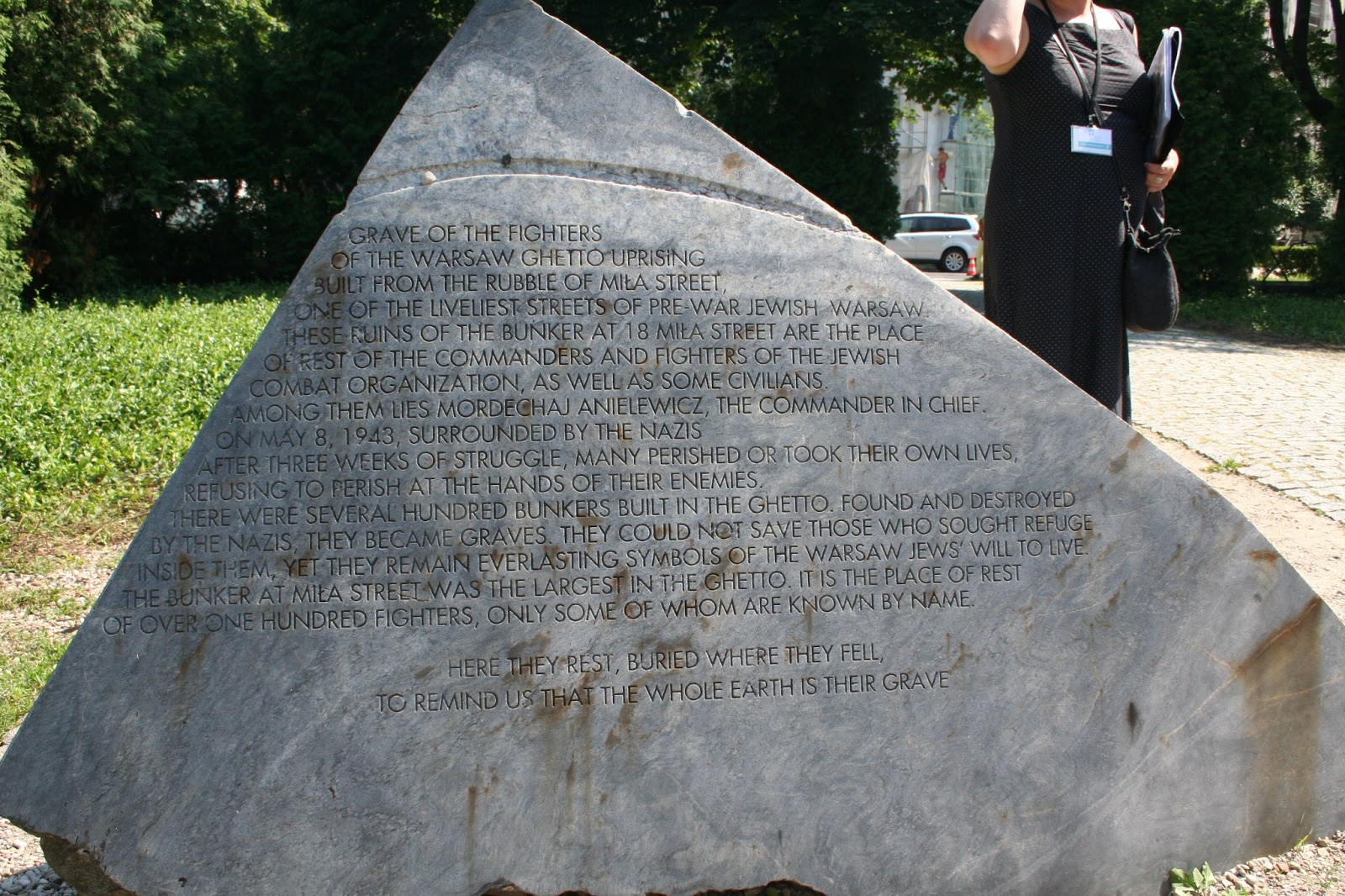During the few months leading up to my departure date for Poland,
all I could think about was visiting museums in Warsaw and Krakow. As I
continue to work towards a MA in Museum Studies, I am conscious about observing the content, message, and display techniques in museums that I visit. I will discuss the Museum of the History of
Polish Jews, the Warsaw Uprising Museum, and the exhibition "Krakow under Nazi Occupation: 1939-1945," which is located at the site of Oskar Schindler’s Factory.
The Museum of the History
of Polish Jews
The Museum of the History of Polish Jews in Warsaw is not
completely open to the public, but we were able to tour some of the building and watch a
video about the future exhibits. It is clear that careful thought and planning
was put into the creation of the mission of the museum and the physical
building.
The museum aims to tell the story of Jews in Poland by discussing
their rich culture and contributions to Polish society. The architect of the
building designed the main lobby to resemble the parting of the Red Sea.
 |
| Entrance to the Museum of the History of Polish Jews |
The design of the main lobby made me feel trapped. Some of the
other people on our tour suggested that it felt like a “wound in history” and a
journey from darkness to light. I am impressed that the architect was able to
make me think in such a critical way and make me feel connected to the story of
the Jews in Poland simply with the shape of the lobby.
The architect set the
tone and feeling of the museum by addressing the complex past of
the Jews in Poland. The front entrance of the building faces the Warsaw Ghetto Heroes
Memorial, which reminds us of the brutal experiences of Jews during the German occupation in World War II.
 |
| Looking out on the Warsaw Ghetto Heroes Memorial |
In contrast, the back side of the building faces a large field which is open to the public for leisurely purposes.
 |
| Looking out on an open field |
The building addresses darkness and death, while also remembering to reflect on light and life. I hope that I will be able to return to the museum when it is completed. It is important to discuss and learn about difficult topics in history, but it is also crucial to realize that history is made by people who had lives, families, and careers. This museum appears to tackle this balance well.
The Warsaw Uprising Museum
The Warsaw Uprising Museum was my favorite museum.
During my first few minutes in the museum I was bombarded with emotions and
thoughts. The words “intense,” "overwhelming,” “moving,” and “real” came to
mind as I took in the design and display of the content.
This museum does an
excellent job of recreating the atmosphere of the Warsaw Uprising of August-October 1944. Dark and blunt colors were used to create intensity. Cobblestone, wooden,
and uneven brick floors mimic the actual look of the streets at that time.
 |
| Inside the Warsaw Uprising Museum |
There were smells that made me feel like a part of the history, and the use of
noises -- such as planes, bombs, music, and voices -- brought the events back to
life.
 |
| Model plane producing sound effects of dropping bombs |
Because the museum discusses an extremely specific event, I was pleased
to notice that all labels and exhibit text panels are similar. This creates a
sense of continuity that gives the museum an impressive flow. Gruesome materials
are hidden so that visitors have the opportunity to choose if they want to
view them.
One section of the museum is made to resemble the sewers that
the fighters stayed in during the Uprising. The floor is uneven, the sound of
running water is present, and the tunnel is dark and damp.
 |
| Inside the sewers |
 |
| View from the sewers of a plane overhead |
This museum is respectful and effective in conveying the feelings
and events of the Uprising. It is also very engaging; I left feeling overwhelmed, but I
believe that the museum curators intend to make visitors feel that way. It is
impressive to say the least!
Schindler’s Factory
Schindler’s Factory is extremely similar to the Warsaw Uprising
Museum in terms of successfully portraying the look and feel of the time period.
 |
| Marker outside of Schindler's Factory |
The museum focuses
on the story of Oskar Schindler, a German who saved the lives of Jewish
workers at his factory. The museum places this episode within the overall story of the German occupation in Krakow.
 |
| Nazi flags on exhibit inside the museum at Schindler's Factory |
The Nazi occupation of Krakow is introduced in innovative and effective ways.
 |
| Flooring at the museum at Schindler's Factory |
Overall, this museum utilized noises, lighting, and reproductions of buildings, trains, and streets to bring alive the history of the German occupation of Krakow during World War II.
Posted by Kaleigh Ratliff




























.JPG)


























